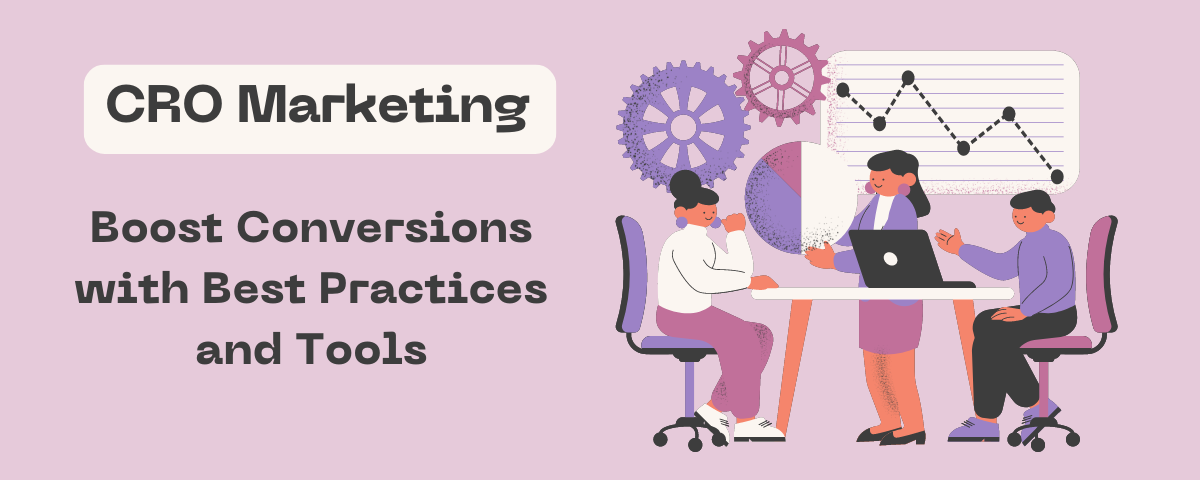
How to Start a Small Business : Step by Step Tutorial.
August 19, 2024
How to Get More Traffic with Related Keyword Research?
September 20, 2024What is CRO marketing?
CRO marketing stands for Conversion Rate Optimization marketing. It is the process of improving the percentage of website visitors who take a desired action, such as making a purchase, signing up for a newsletter, or filling out a form. The main goal of CRO is to enhance the overall performance of a website by optimizing various elements, such as landing pages, forms, buttons, and content, to encourage more conversions.
CRO marketing focuses on understanding user behavior, identifying bottlenecks or areas where visitors drop off, and testing different strategies to increase the likelihood of users completing the desired action. This can involve A/B testing, usability testing, and making data-driven changes to improve the user experience.
How does CRO Marketing work?
CRO (Conversion Rate Optimization) operates by continuously optimizing elements of a website to increase the number of users who take desired actions. Here’s an overview of the CRO marketing process:
- Data Collection and Analysis: Tools such as Google Analytics and heatmaps gather user behavior data, helping to pinpoint areas where visitors abandon the site or struggle with navigation. These insights are crucial for optimizing website performance.
- Identifying Goals: CRO marketing efforts begin with clear goals, like increasing product purchases or form submissions. Setting goals helps define conversion success for specific marketing campaigns.
- Hypothesis and Testing: After data analysis, hypotheses are made on what could improve conversions. Testing methods like A/B testing and multivariate testing are employed to compare different versions of a webpage or element to see which one performs better.
- Implementing Changes: Successful tests lead to site-wide implementation of changes. This may include optimizing design, improving CTAs, or simplifying navigation for a better user journey.
- Monitoring and Iteration: CRO marketing is an ongoing effort. The site is continuously monitored to ensure changes are driving results, and further adjustments are made to maintain growth.
In summary, CRO marketing is about understanding user behavior, identifying pain points, and implementing and testing strategies to remove obstacles, leading to improved conversions.
Why is CRO Marketing important?
CRO Marketing (Conversion Rate Optimization) is important because it directly impacts a business’s success by maximizing the effectiveness of its website or digital platform. Here’s why it matters:
1. Maximizes Revenue Without More Traffic
Instead of spending more money on attracting new visitors through ads or other marketing efforts, CRO marketing helps businesses generate more conversions without needing additional traffic, saving on advertising and marketing costs.
2. Enhances User Experience
CRO focuses on understanding how users interact with a site and eliminating any barriers to conversion. By removing friction in the user journey, CRO marketing makes websites more user-friendly, increasing satisfaction and trust.
3. Improves ROI
Businesses often spend a lot of money on marketing to drive traffic. CRO ensures that this investment pays off by converting more visitors into customers or leads, leading to a better return on investment (ROI) for marketing efforts.
4. Increases Customer Insights
CRO involves analyzing user behavior, running tests, and experimenting with different strategies. This provides valuable insights into what users want, how they behave, and what drives them to convert, helping businesses make informed decisions across their marketing and product strategies.
5. Reduces Customer Acquisition Costs
When your conversion rate improves, the cost of acquiring each customer decreases. This is because you are converting more visitors into customers without increasing your spending on ads or other traffic-generating methods.
6. Long-term Growth
Optimizing conversions can lead to long-term benefits, such as improved brand reputation, customer retention, and overall business growth. The insights and improvements gained through CRO often have a lasting positive impact.
7. Competitive Advantage
In competitive markets, CRO can be a key differentiator. A business that efficiently converts visitors into customers will outperform competitors who are simply focused on driving traffic without optimizing for conversions.
In summary, CRO is essential because it helps businesses maximize their website’s potential, leading to more sales, improved user satisfaction, and better use of marketing budgets.
How to start CRO?
Starting with CRO (Conversion Rate Optimization) can seem complex, but by following a structured approach, you can make significant improvements to your website’s conversion rate. Here’s a step-by-step guide on how to begin:
1. Set Clear Goals
Before starting CRO, define what “conversion” means for your business. It could be increasing product sales, getting more newsletter sign-ups, improving form submissions, or encouraging more downloads of an app. Clear goals will guide your CRO efforts.
2. Understand Your Audience
Use tools like Google Analytics to study user behavior. Identify where visitors are coming from, what pages they visit most, and where they drop off. This data provides a foundation for knowing which areas of your site need optimization.
3. Analyze Current Performance
Use data analysis tools like heatmaps, user recordings, and click maps to see how visitors are interacting with your site. These tools help you understand pain points in the user experience, such as confusing navigation or cluttered layouts.
4. Identify Bottlenecks and Opportunities
Look for pages or parts of your site where visitors are not completing the desired action. For example, if you notice a high bounce rate on your checkout page, this might be an opportunity for improvement. Focus on improving high-traffic pages that are underperforming.
5. Form Hypotheses
Based on the data, create hypotheses about what changes might improve conversions. For example, “If we reduce the number of fields in our sign-up form, more people will complete it.” Make sure each hypothesis is specific and testable.
6. Run A/B Tests
Test your hypotheses through A/B testing. This involves creating two versions of a webpage (the original and a modified one) and showing them to different users to see which one performs better. Focus on one change at a time, such as tweaking headlines, changing CTA buttons, or adjusting page layouts.
7. Implement Changes Based on Results
Once the tests have been run, analyze the results. If the new version performs better, implement it permanently across the site. If it doesn’t, analyze why and tweak your approach for the next round of testing.
8. Monitor and Optimize Continuously
CRO is an ongoing process. Monitor your site’s performance after making changes, and continue testing new ideas. The digital landscape and user behavior evolve, so constant optimization is necessary to maintain and improve conversion rates.
9. Use CRO Tools
There are many tools available to help with CRO, such as:
- Google Analytics for performance tracking
- Hotjar or Crazy Egg for heatmaps and user session recordings
- Optimizely or VWO for A/B testing
10. Involve Your Team
CRO often involves various teams, including marketing, design, and development. Collaborate with them to gather different perspectives, make necessary changes, and ensure that your CRO efforts align with broader business goals.
In short, starting CRO involves understanding your audience, setting clear goals, analyzing data, testing different strategies, and continuously optimizing your website.
What are CRO tools?
CRO (Conversion Rate Optimization) tools are software solutions designed to help businesses analyze user behavior, test changes, and optimize their website for better conversion rates and CRO marketing. These tools assist in tracking, analyzing, and improving various elements of a site to increase the percentage of visitors who complete desired actions. Here are some popular CRO tools:
1. Google Analytics
Purpose: Tracks and analyzes website traffic. Features: Provides insights into user behavior, traffic sources, bounce rates, and conversions. It helps you understand how visitors interact with your website, which pages perform well, and where you lose potential customers.
2. Hotjar
Purpose: Provides heatmaps and user behavior insights. Features: Heatmaps show where users are clicking, scrolling, and spending time on your site. Hotjar also offers session recordings, allowing you to see exactly how individual visitors navigate your website.
3. Crazy Egg
Purpose: Visualizes user activity on a website. Features: Offers click tracking, heatmaps, and scroll maps to show how users engage with a page. Crazy Egg helps identify where visitors are getting stuck or dropping off.
4. Optimizely
Purpose: A/B testing and experimentation platform. Features: Allows you to run A/B tests and multivariate tests on different versions of your website to see which one performs better in terms of conversions. It also offers personalization features to tailor content to individual users.
5. VWO (Visual Website Optimizer)
Purpose: Comprehensive CRO platform for testing and optimization. Features: Includes A/B testing, multivariate testing, heatmaps, and user surveys. VWO allows businesses to experiment with different website elements and track the results to optimize for conversions.
6. Unbounce
Purpose: Landing page optimization and A/B testing. Features: A platform designed for building and optimizing landing pages. It helps you create custom landing pages without coding and run A/B tests to find the best-performing designs and messaging.
7. Kissmetrics
Purpose: Behavioral analytics and conversion tracking. Features: Tracks individual user behavior across your site and provides detailed reports on user journeys, helping you understand what actions lead to conversions.
8. Crazy Egg
Purpose: Website heatmaps and behavior analytics. Features: Provides tools like heatmaps, scroll maps, and A/B testing to visualize where users click and scroll on your website. Helps identify bottlenecks in user engagement.
9. SurveyMonkey
Purpose: User feedback collection. Features: Helps gather insights from users by creating surveys that can inform CRO strategies. Understanding customer opinions can help guide improvements that lead to better conversion rates.
10. UserTesting
Purpose: User experience testing. Features: Allows businesses to observe real users interacting with their website or app. The feedback and recordings offer insights into potential issues with usability, helping improve conversions.
11. Google Optimize
Purpose: A/B testing and personalization. Features: Integrated with Google Analytics, it allows you to run A/B and multivariate tests on your website. You can experiment with different content or layout variations and track which one drives the most conversions.
12. FullStory
Purpose: User session recording and analysis. Features: Records user sessions, providing detailed insights into how visitors navigate your site. FullStory helps identify areas where users experience friction or drop-off.
Best CRO practices?
The best CRO (Conversion Rate Optimization) practices involve a combination of understanding user behavior, testing, and making data-driven decisions to improve website performance. These practices help maximize the chances of turning visitors into customers. Here are some of the best CRO practices:
1. Understand Your Audience
- Use tools like Google Analytics, heatmaps, and user surveys to gather insights into how visitors interact with your site. Knowing your audience’s needs and pain points is crucial for improving conversions.
2. Focus on Mobile Optimization
- Ensure your website is fully responsive and user-friendly on mobile devices. A significant amount of traffic comes from mobile users, so optimizing for smaller screens can greatly improve your conversion rate.
3. Simplify Forms
- Long or complicated forms can discourage users from completing a desired action. Minimize the number of fields required, use autofill where possible, and break long forms into smaller steps to make it easier for users to complete.
4. Optimize Your Call-to-Actions (CTAs)
- Your CTAs should be clear, visible, and compelling. Use action-oriented language like “Get Started” or “Buy Now.” Make sure the CTA stands out on the page, using contrasting colors and large buttons to draw attention.
5. Run A/B Tests Regularly
- A/B testing allows you to test different versions of a webpage or element (like CTAs, headlines, or images) to see which performs better. Make sure to test only one change at a time to get clear results.
6. Improve Page Load Speed
- Fast-loading pages lead to better user experiences. Slow sites can frustrate users and lead to higher bounce rates. Optimize images, use caching, and compress files to ensure your site loads quickly on all devices.
7. Use Social Proof
- Add testimonials, reviews, and case studies to your site to build trust. Displaying how others have benefitted from your product or service can persuade new visitors to convert.
8. Create Engaging and Relevant Content
- Your content should be tailored to the needs and interests of your audience. Write clear, concise, and compelling copy that addresses user pain points and provides value. Ensure that your messaging aligns with your audience’s intent and is easy to understand.
9. Optimize for SEO
- A website that ranks well on search engines can attract more relevant traffic. Focus on on-page SEO elements like title tags, meta descriptions, and keyword optimization to ensure you’re attracting the right audience who are more likely to convert.
10. Reduce Distractions on Conversion Pages
- On key pages, like landing pages or checkout pages, reduce distractions that could divert visitors from completing the desired action. Remove unnecessary navigation options, excessive links, and cluttered designs to keep the user focused.
11. Use Personalization
- Personalized experiences can increase engagement and conversions. Use data to personalize content, offers, and product recommendations based on a visitor’s previous behavior, location, or preferences.
12. Leverage Exit-Intent Popups
- Exit-intent popups appear when users are about to leave your site. Offer a discount, special offer, or another incentive to capture their attention and encourage them to stay or complete a purchase.
13. Ensure a Smooth Checkout Process
- A complicated or lengthy checkout process can cause cart abandonment. Simplify your checkout flow by offering guest checkout, providing multiple payment options, and reducing the number of steps.
14. Track and Analyze Conversion Funnels
- A conversion funnel tracks a visitor’s journey from landing on your site to completing a conversion. Analyze where users drop off in the funnel and optimize those stages to improve the flow.
15. Create Clear and Engaging Landing Pages
- Design landing pages with a single focus—whether it’s signing up for a newsletter, downloading an eBook, or making a purchase. Avoid overloading visitors with information and make sure your CTA is prominent.
16. Use High-Quality Images and Videos
- Visual content helps engage users and build trust. Use professional images or videos to showcase your products, demonstrate features, or tell your brand’s story.
17. Retargeting
- Use retargeting ads to bring back visitors who didn’t convert on their first visit. These ads can remind users of items left in their cart or provide additional incentives to return.
18. Ensure Website Security and Build Trust
- Adding trust signals like SSL certificates, secure payment badges, and privacy policies can reassure visitors that your site is safe, increasing their likelihood of converting.
19. Use Scarcity and Urgency Tactics
- Adding urgency (e.g., “Limited-time offer” or “Only 3 left in stock”) can motivate users to act quickly. However, ensure that the urgency is genuine to maintain trust.
20. Regularly Monitor and Adjust
- CRO is an ongoing process. Regularly monitor performance, track changes, and adjust your strategies based on new data and user behavior.
In summary, the best CRO practices involve focusing on the user experience, testing changes, reducing friction in the conversion process, and constantly making data-driven decisions to optimize results.




